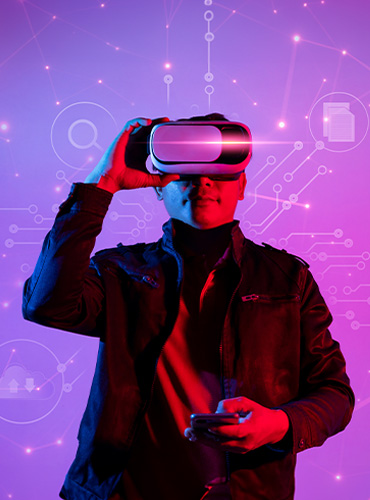
Virtual reality customer experience represents one of today’s most promising business opportunities. Consider this: 61% of consumers say they would prefer buying from brands that offer VR or AR technology. Yet only 1% of retailers currently use extended reality, while 63% plan to adopt it within the next two years.
The pandemic showed us what happens when traditional customer touchpoints disappear. We couldn’t visit museums, attend exhibitions, or experience products firsthand. Smart organizations like the British Museum responded by creating immersive virtual tours of their collections. This wasn’t just adaptation—it was strategic customer experience design.
The numbers tell a compelling story. The global XR market is projected to reach $300 billion by 2024. We’re looking at approximately 1.7 billion mobile augmented reality users by that same timeframe. These technologies create new pathways for building customer relationships, strengthening brand connections, and driving sales growth.
What does this mean for your business? Opportunity.
This guide shows you how virtual reality and augmented reality can elevate your customer experience strategy and fuel measurable business growth.
Understanding Virtual Reality in Customer Experience
Virtual reality changes how businesses connect with customers. This isn’t just another tech trend—it’s a strategic shift that creates new possibilities for customer engagement. Here’s what you need to know about VR and why it matters for your business growth.
What is virtual reality and how it works
Virtual reality creates immersive 3D environments through computer-generated simulations that respond to user interactions via headsets, goggles, gloves, or body suits. The key difference? VR places users inside the virtual environment rather than observing it from outside.
The technology works through precise coordination between hardware and human perception. VR systems override your senses using tracking sensors and stimulation devices that respond to your movements in real time. When you wear a VR headset, stereoscopic screens create depth perception while motion sensors track your head movements, adjusting the visual field accordingly.
Every VR system relies on three core components:
- Displays that generate visual content
- Sensors that monitor user movement
- Computers that process and render the virtual world
The goal? Convince your brain that the virtual experience is real by stimulating neurological pathways the same way physical environments do.
Difference between VR, AR, and XR
Choosing the right technology for your business requires understanding these distinctions:
Virtual Reality (VR) creates completely digital environments that replace the physical world. Users experience fully virtual spaces constructed from computer graphics and simulations. This works best for focused activities like training programs or product demonstrations.
Augmented Reality (AR) adds digital elements to real-world environments. Instead of replacing reality, AR enhances it by overlaying virtual information onto physical spaces. This approach suits applications where users need awareness of their surroundings.
Extended Reality (XR) encompasses all immersive technologies along the reality-virtual spectrum. It includes every technology that blends virtual and physical elements. The global market expected to reach $300 billion by 2024 reflects XR’s growing adoption across industries.
Why immersive tech matters for CX
Immersive technologies create presence—the feeling of “being there”—that traditional media cannot match. This presence fundamentally changes how customers interact with your brand.
VR engages multiple senses simultaneously, creating richer customer experiences. Companies using immersive technologies report 46% reduction in task completion time and 32% average productivity improvements. These technologies make digital information feel physical, allowing customers to see, hear, touch, and interact with virtual elements naturally.
The emotional impact proves particularly powerful. The North Face uses immersive experiences to connect customers with their brand through virtual adventures in Nepal and the South Pole. These emotional connections drive customer engagement beyond traditional marketing methods.
VR also solves practical customer problems. Consider IKEA’s virtual kitchen design tools or remote troubleshooting applications that work better than traditional e-commerce or physical stores alone. Homebuyers tour properties virtually while fashion customers try on clothes from home.
What sets immersive technology apart? It transforms passive customers into active participants, creating deeper brand connections through hands-on experiences.
Key Benefits of VR for Business Growth

Businesses implementing VR report measurable growth across multiple metrics. Many achieve significant ROI from immersive technology investments. Four key benefits drive business expansion through virtual reality customer experience.
Improved product visualization
Virtual reality changes how customers preview products. This creates competitive advantages that translate directly into sales performance.
VR enables customers to interact with products in three dimensions. The results speak for themselves:
- Greater purchase confidence: Retailers utilizing AR/VR reported a 25% reduction in product returns
- Cost-effective development: Companies test product designs in simulated environments without building physical prototypes
- Accelerated innovation cycles: Virtual testing enables rapid iteration without physical production costs
Siemens partnered with NVIDIA to build virtual replicas of physical products with real-time data for design testing before manufacturing begins. This approach saves money and speeds up product development cycles.
Higher customer engagement
VR creates engagement levels that traditional media cannot match. Brands implementing VR experiences see remarkable improvements in customer interactions.
The data is compelling: customers using AR/VR reported feeling 40% more emotionally connected to products and brands. Retailers using VR in stores noted customer dwell time increasing by 50%.
This engagement drives business results. Companies using immersive technology report average conversion rate increases of 20%. Some see conversion rates improve by up to 40% for products showcased through virtual try-on features.
Personalized and interactive experiences
VR’s most powerful advantage lies in personalization capabilities. Unlike one-size-fits-all marketing, VR creates tailored experiences that respond to individual preferences and behaviors.
Research shows 62% of consumers prefer shopping with retailers offering personalized VR/AR experiences. These technologies enable product customization in real-time, allowing customers to visualize customized options instantly.
IKEA’s AR-powered app demonstrates this perfectly. Customers virtually place furniture in their homes using smartphone cameras. Users rotate, move, and walk around virtual products—testing fit with their space and style before purchasing.
Boost in customer loyalty and retention
Virtual reality strengthens long-term customer relationships. VR creates emotional connections that foster brand advocacy and encourage repeat business.
The numbers support this connection between immersive experiences and loyalty. Retailers like Gucci implementing VR experiences saw a 45% increase in brand loyalty, especially among younger consumers. Over 70% of consumers report greater loyalty toward brands implementing AR or VR product visualization.
The reason? These technologies make customers feel understood. Companies using VR report better customer retention rates over time by providing innovative ways to explore products and services.
Real-World Applications Across Industries
Smart businesses across industries understand one thing: VR success comes from solving real customer problems. We’ve seen companies achieve remarkable results when they focus on practical applications that deliver genuine value. Here’s how different sectors are winning with virtual reality.
Healthcare: VR for therapy and consultations
Healthcare professionals recognize VR’s power for training, pain management, and mental health treatment. The breakthrough came in November 2021 when the FDA approved EaseVRx, a prescription VR system for chronic pain management. Cedars-Sinai Hospital discovered VR experiences can reduce pain by 24% or more.
Mental health applications show equal promise. VR exposure therapy reduces fear of heights by an average of 68%. Mayo Clinic leads innovation with software that improves neurological evaluations for stroke victims and AR platforms giving surgeons “3D holographic X-Ray vision” during procedures.
Automotive: Virtual showrooms and test drives
Car manufacturers face geographic limitations and high operational costs for test drives. VR eliminates both challenges. Customers can “test drive” vehicles from anywhere while dealerships reduce costs associated with physical demonstrations.
Audi pioneered virtual reality test drives in showrooms, allowing customers to experience more than 40 models in real-time. BMW and Mercedes-Benz report improved customer satisfaction and higher conversion rates after implementing VR in their sales processes.
Tourism: Immersive travel previews
Tourism companies discovered VR’s marketing potential early. Thomas Cook’s “Try Before You Fly” VR experience created a 190% uplift in New York excursion bookings after customers experienced their 5-minute virtual preview. The global virtual tourism market, valued at $5 billion in 2021, is projected to reach $24 billion by 2027.
Nearly 50% of people would use VR when choosing holiday destinations, appreciating its ability to “bring a destination to life”. Tourism Australia found approximately 20% of consumers have already used VR to select holiday destinations.
Education: Interactive learning environments
Educational institutions create immersive learning experiences accessible from anywhere. A PwC study revealed VR learners were 4x faster to train than classroom learners, 275% more confident applying skills learned, and 3.75x more emotionally connected to content.
Students can virtually explore historical sites, conduct science experiments safely, and participate in hands-on simulations. This technology benefits STEM subjects, medical training, cultural education, and special education programs.
What makes these applications successful? Each solves specific customer problems while creating measurable business value.
Challenges in Implementing VR for CX
Virtual reality delivers impressive results, but smart businesses plan for implementation realities. Four primary considerations require strategic attention when adopting VR solutions.
VR implementation requires significant upfront investment. Development costs for interactive CG-based VR applications typically range between $150,000 and $200,000. Simple VR apps still require $3,000 to $15,000 for mobile platforms. Hardware expenses add another layer, with quality headsets starting around $200 per unit.
The economics improve with scale. Research shows VR training reaches cost parity with in-person training at just 375 users, indicating strong long-term value for businesses with sufficient volume.
Limited accessibility for all users
Accessibility presents real challenges that organizations must address. Approximately one in four adults in the United States has some form of disability, creating barriers for VR adoption. Users with limited mobility face difficulties setting up systems, wearing headsets, and operating controllers. Many VR experiences require standing, automatically excluding users who cannot do so.
Smart implementation includes alternative participation methods to ensure inclusive experiences for all customers.
Data privacy and security concerns
VR systems collect extensive user data, including physiological responses, movement patterns, and eye-tracking information. This creates unique security vulnerabilities where hackers could access highly personal biometric data. Many users don’t understand how companies use this information, raising important questions about data storage, sharing practices, and regulatory compliance like GDPR.
Businesses implementing VR must establish clear data governance policies from the start.
Risk of poor user experience design
Poorly designed VR experiences cause simulation sickness in 25-40% of users. Additional problems include uncomfortable hardware, disorientation, and eye fatigue during extended use. Without proper user-centered design, businesses risk creating frustrating experiences that damage rather than enhance customer relationships.
Each business is different, so are the implementation challenges. This is why we recommend thorough planning and testing before full deployment.
Building VR Into Your Customer Experience Strategy
Building virtual reality into your customer experience strategy demands strategic thinking, not just technological implementation. Each business faces different challenges, which is why we recommend a methodical approach that addresses your specific customer needs.
What challenges do your customers actually face? Customer journey pain points typically fall into four categories: process, financial, support, and product issues. Before investing in VR technology, conduct qualitative research through open-ended surveys asking questions like “What was your greatest struggle during the sales process?”. This ensures your VR solution solves genuine problems rather than adding complexity for its own sake.
Our experience shows that successful VR implementations start with clear problem identification. Without this foundation, even the most sophisticated technology becomes an expensive distraction.
Select the right technology platform
Choosing appropriate VR technology depends entirely on your business objectives and constraints. Start by evaluating hardware options based on budget, ease of use, and scalability requirements. Cost-effective choices like the Pico 4E deliver similar capabilities to premium alternatives at significantly lower price points—crucial when scaling across hundreds or thousands of devices.
We recommend focusing on platforms that grow with your business rather than those offering the most features upfront.
Test everything with real users
Deploy pilot programs with small user groups before full implementation to identify usability challenges. Your testing should evaluate haptic feedback, sound positioning, text readability, and navigation—all elements that affect user comfort and engagement. Continuous feedback collection enables refinement based on actual user experiences rather than assumptions.
Smart businesses test early and iterate quickly. This approach prevents costly mistakes and ensures user adoption.
Create seamless multichannel experiences
Develop integrated support systems where customers can move smoothly between different interaction methods. An effective approach might enable users to begin with a chatbot, escalate to voice support, and transition into VR environments for complex problem-solving. This creates hybrid support models that combine human empathy, AI efficiency, and immersive technology.
The goal isn’t replacing existing channels—it’s enhancing them with strategic VR integration.
Conclusion
Virtual reality has moved past the experimental phase. Smart businesses now recognize immersive technology as essential for competitive customer experiences. We’ve explored how VR creates stronger connections between your brand and customers, delivering measurable growth across industries.
The evidence speaks for itself. Better product visualization builds purchase confidence while cutting return costs. Customers form deeper emotional bonds with brands that offer immersive experiences. Personalization reaches new levels when customers can interact with your products in virtual environments.
Real businesses achieve real results through strategic VR implementation. Retail brands solve the try-before-you-buy challenge that has plagued e-commerce. Healthcare organizations reduce patient pain and improve treatment outcomes. Automotive companies break geographical barriers with virtual showrooms. Tourism operators boost bookings through destination previews. Educational institutions accelerate learning through hands-on virtual experiences.
Success requires acknowledging the challenges. Budget considerations, accessibility requirements, privacy safeguards, and user experience design all demand careful planning. Each business faces different obstacles, which is why cookie-cutter solutions don’t work.
Smart implementation starts with understanding your customers’ specific pain points. The right platform depends on your unique objectives and constraints. Testing with real users before full deployment prevents costly mistakes. Most importantly, VR works best when integrated with your existing customer support channels.
The question isn’t whether VR will shape customer experience—it’s whether your business will lead or follow. Companies ready to invest in strategic immersive technology implementation position themselves for sustained growth in an increasingly digital marketplace.




